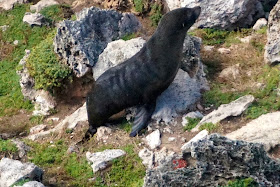We arrived in the twilight. A brushstroke of pink and orange across the sky. Our destination Southern Ocean Lodge. This is a short journey from the capital of the island Kingscote, across to the southern side, but at this time of night, it took a little longer. Kangaroos and Tammar Wallabies are crepuscular (a favourite word of my son George) meaning they like the twilight and tend to come out to feed at dawn and dusk, so we crept along, playing dodgems with the animals along the way. The lodge is settled in the short shrub land overlooking Hanson Bay (see the low lying buildings on the cliff face) and all I can say is that the colours and the panorama are most definitely breathtaking. You could easily spend your entire day gazing out at this wonderful vista.

This island which is the third biggest in OZ, is seven times the size of Singapore and roughly the same size as Long Island, NY. There is one person for each square kilometre. In the UK there are 246 people to a square km, so you can understand that sheep, some cows, but mainly, koalas, echidnas,wallabies and kangaroos predominate here and that makes us very happy.
It was chosen as the first free settlement in the 1800s but what were they thinking ?- it was a logistical nightmare with water in short supply and rough seas to contend with. So Adelaide on the mainland was chosen instead.
Our wildlife guide asked us if we knew what Kangaroo means - apparently when the first explorers came in contact with aboriginals and pointed to the Kangaroo asking them what it was the aboriginals answered "I dont know or I dont understand you" - but this was taken to mean the name of the animal. This is a bit of a myth and unlikely to be true but it is a nice story nevertheless.
It was named Kangaroo Island by Mathew Flinders when he came across it in the 1800s and there is a lot on the island which is so literal Oz - Remarkable Rocks - Bay View Road, Grass tree, Yellow bush pea and the incomparably named plant the Snotty Gobble.
The New Zealand Fur Seals are found at Admiralty Arch, a cavern formed naturally by the wind and the southern ocean. They manage the turbulent waters and then climb up in an agile manner, quite surprising for their little flippers and rounded bodies, to greener areas, where they find a sunny spot and sleep like babies. They are smaller and darker than the sea lions, with long whiskers and external ears.


Further down the coast is Seals Bay which is a sanctuary for the Australian Sea Lion which was so hunted in the 19th Century. Despite being protected now, their numbers are declining and there are only some 15000 left in the wild. The breeding cycle is long- 18 months, and there is quite a high seal pup mortality. These two males have sandwiched a female between them, perhaps in an effort to keep her warm and have fun later on.
My next blog will take us to those originally named Remarkable Rocks also in Flinders Chase ( From the french word Chasse meaning hunting ground ) National Park.









No comments:
Post a Comment
Leave a comment :)